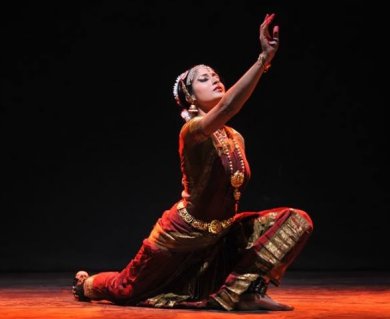
|   |

|   |
Samviksana: An exploration - Shivakumar Pandithar e-mail: spandithar@yahoo.com Photo: Shashank Sane October 20, 2015 Nritya Yatri presented ‘Samviksana: An Exploration,’ a Bharatanatyam recital by Dr. Janaki Rangarajan at Tilak Smarak Mandir, Pune, on October 4, 2015. Janaki commenced her performance with tisra jathi ata tala alarippu in Ragamalika. The precision in each movement was complete, the flow of the dance and the symmetrical positioning of the whole body was a delight to watch.  Janaki performed for Chilean poet Pablo Neruda's poetry which had music by Dr. Rajkumar Bharati. It was about a poet full of emotions, but he did not have the words to describe them; he did not know how to open the barrier and how to fly; when he realized how poetry has come in search of him, he attained fulfillment of happiness. If the vocal in Hindustani ragas in this English poetry was a delight, Janaki visualization of the verse was noteworthy. Varnam gives one an opportunity to wholesomely gauge the mastery of an artist on the overall dance including abhinaya. Janaki performed Sadaya Ika (Chakravakam - adi - Tanjore Quartet) based on Shiva, the lord of Brihadeeswara temple. Janaki’s dance for the teermanams during the varnam was her artistic best, with fine footwork, concluding into immaculate postures. Pining for the lord, the nayika wants him to at least give her a glimpse of his love. Janaki’s use of subtle karana movements drew loud appreciation from the rasikas. We all know how the research on karanas have been Dr. Padma Subrahmanyam’s gift to the field of dance; seeing her shishya perform them were testimonies of how they today are an integral part of dance. Throughout the varnam, the dancer seemed to take the rasikas to a higher level of experience through her nritta and abhinaya, while her hallmark angasuddhi and araimandi remained sublime. It was a treat to see the artiste move into the three characters of Shiva, Parvathi and the nayika, the moment of anger as Parvathi looks into Shiva’s heart and feels that there was somebody else and not herself, the lord pacifying Parvathi. The magical moment was Shiva and Parvathi coming together as Ardhanari Nateshwara, well choreographed by the dancer herself. Rasikas were delighted to see the depiction of various rasas as the dancer transcended from one character to another with ease. The depiction of the Brihadeeswara temple and its grandeur was another notable moment in this item. Draupadi’s Dharma with lyrics by Pramila Venkateswaran and music by Dr. Rajkumar Bharati was a dialogue poetry between Draupadi and Dharmaraj Yudhishter. She questions him about when her revenge would be completed; she questions him on why he is so silent, why he was so in the sabha where she was shamed by the Kauravas. The dancer depicted the humiliation of Draupadi convincingly, enacting Dushasana’s role with aplomb, his body language when he is about to outrage Draupadi, the bhaya and karuna in Draupadi. Janaki performed the ashtapadi “Kuru Yadu” from Jayadeva’s Geetagovinda. A departure from many occasions of watching Radha yearn for the love of her beloved Krishna, this item presented by the artiste showcased Radha as one who has earned a lot of love from Krishna. Radha wants Krishna to help her through various acts of beautification. Sitting in one position on the stage, the dancer could juggle into both the characters. It was a delight watching the sambhoga sringara presentation. It was rare to see Bharatanatyam performed on Sufi poem ‘Juda’ by Amir Khusrau, a beautiful poem well put into beautiful motion of dance. It was interesting to see sufi chakkars being performed in Bharatanatyam. Janaki concluded with a thillana in Purvi composed by T. Vaidyanatha Bhagavathar. Once again, the hint of karanas in the tillana added to the beauty of the item. One of the highlights of Janaki’s performance was the ease of connect she could have with the rasikas, who complemented her artistic brilliance throughout the recital. |